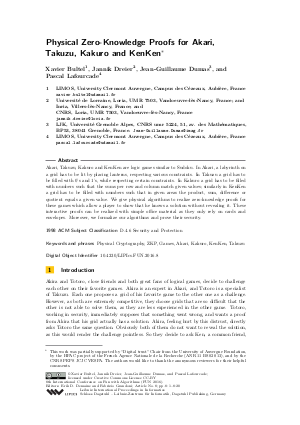Physical Zero-Knowledge Proofs for Akari, Takuzu, Kakuro and KenKen
Authors Xavier Bultel, Jannik Dreier, Jean-Guillaume Dumas, Pascal Lafourcade
-
Part of:
Volume:
8th International Conference on Fun with Algorithms (FUN 2016)
Part of: Series: Leibniz International Proceedings in Informatics (LIPIcs)
Part of: Conference: International Conference on Fun with Algorithms (FUN) - License:
 Creative Commons Attribution 3.0 Unported license
Creative Commons Attribution 3.0 Unported license
- Publication Date: 2016-06-02
File

PDF
LIPIcs.FUN.2016.8.pdf
- Filesize: 0.58 MB
- 20 pages
Document Identifiers
Subject Classification
Keywords
- Physical Cryptography
- ZKP
- Games
- Akari
- Kakuro
- KenKen
- Takuzu
Metrics
- Access Statistics
-
Total Accesses (updated on a weekly basis)
0Document
0Metadata
Abstract
Akari, Takuzu, Kakuro and KenKen are logic games similar to Sudoku. In Akari, a labyrinth on a grid has to be lit by placing lanterns, respecting various constraints. In Takuzu a grid has to be filled with 0's and 1's, while respecting certain constraints. In Kakuro a grid has to be filled with numbers such that the sums per row and column match given values; similarly in KenKen a grid has to be filled with numbers such that in given areas the product, sum, difference or quotient equals a given value. We give physical algorithms to realize zero-knowledge proofs for these games which allow a player to show that he knows a solution without revealing it. These interactive proofs can be realized with simple office material as they only rely on cards and envelopes. Moreover, we formalize our algorithms and prove their security.
Cite As Get BibTex
Xavier Bultel, Jannik Dreier, Jean-Guillaume Dumas, and Pascal Lafourcade. Physical Zero-Knowledge Proofs for Akari, Takuzu, Kakuro and KenKen. In 8th International Conference on Fun with Algorithms (FUN 2016). Leibniz International Proceedings in Informatics (LIPIcs), Volume 49, pp. 8:1-8:20, Schloss Dagstuhl – Leibniz-Zentrum für Informatik (2016)
https://doi.org/10.4230/LIPIcs.FUN.2016.8
BibTex
@InProceedings{bultel_et_al:LIPIcs.FUN.2016.8,
author = {Bultel, Xavier and Dreier, Jannik and Dumas, Jean-Guillaume and Lafourcade, Pascal},
title = {{Physical Zero-Knowledge Proofs for Akari, Takuzu, Kakuro and KenKen}},
booktitle = {8th International Conference on Fun with Algorithms (FUN 2016)},
pages = {8:1--8:20},
series = {Leibniz International Proceedings in Informatics (LIPIcs)},
ISBN = {978-3-95977-005-7},
ISSN = {1868-8969},
year = {2016},
volume = {49},
editor = {Demaine, Erik D. and Grandoni, Fabrizio},
publisher = {Schloss Dagstuhl -- Leibniz-Zentrum f{\"u}r Informatik},
address = {Dagstuhl, Germany},
URL = {https://drops.dagstuhl.de/entities/document/10.4230/LIPIcs.FUN.2016.8},
URN = {urn:nbn:de:0030-drops-58693},
doi = {10.4230/LIPIcs.FUN.2016.8},
annote = {Keywords: Physical Cryptography, ZKP, Games, Akari, Kakuro, KenKen, Takuzu}
}
Author Details
References
-
Michael Ben-Or, Oded Goldreich, Shafi Goldwasser, Johan Håstad, Joe Kilian, Silvio Micali, and Phillipe Rogaway. Everything provable is provable in zero-knowledge. In CRYPTO'88, pages 37-56. Springer, 1990.

- Marzio De Biasi. Binary puzzle is NP-complete. 2012. URL: http://www.nearly42.org/vdisk/cstheory/binaryp.pdf.
-
Manuel Blum, Paul Feldman, and Silvio Micali. Non-interactive zero-knowledge and its applications. In STOC'88, pages 103-112. ACM, 1988.

-
Yu-Feng Chien and Wing-Kai Hon. Cryptographic and physical zero-knowledge proof: From sudoku to nonogram. In Fun with Algorithms, 5th International Conference, FUN'10, volume 6099 of LNCS, pages 102-112, 2010.

-
Erik D. Demaine. Playing games with algorithms: Algorithmic combinatorial game theory. In Mathematical Foundations of Computer Science 2001, volume 2136 of LNCS, pages 18-32, 2001.

-
Jannik Dreier, Hugo Jonker, and Pascal Lafourcade. Secure auctions without cryptography. In Fun with Algorithms, 7th International Conference, FUN'14, pages 158-170, 2014.

-
Oded Goldreich and Ariel Kahan. How to construct constant-round zero-knowledge proof systems for NP. Journal of Cryptology, 9(3):167-189, 1991.

-
Shafi Goldwasser, Silvio Micali, and Charles Rackoff. The knowledge complexity of interactive proof-systems. In STOC'85, pages 291-304. ACM, 1985.

-
Ronen Gradwohl, Moni Naor, Benny Pinkas, and Guy N. Rothblum. Cryptographic and physical zero-knowledge proof systems for solutions of sudoku puzzles. In Fun with Algorithms, 4th International Conference, FUN'07, pages 166-182. Springer-Verlag, 2007.

-
Kazuya Haraguchi and Hirotaka Ono. BLOCKSUM is NP-complete. IEICE Transactions, 96-D(3):481-488, 2013.

-
Kazuya Haraguchi and Hirotaka Ono. How simple algorithms can solve latin square completion-type puzzles approximately. JIP, 23(3):276-283, 2015.

-
Graham Kendall, Andrew J. Parkes, and Kristian Spoerer. A survey of NP-complete puzzles. ICGA Journal, 31(1):13-34, 2008.

-
Jonas Kölker. I/O-Efficient Multiparty Computation, Formulaic Secret Sharing and NP-Complete Puzzles. PhD thesis, Aarhus University, 2012.

- Brandon McPhail. Light up is NP-complete. feb 2005. URL: http://www.mountainvistasoft.com/docs/lightup-is-np-complete.pdf.
-
Alfred J. Menezes, Scott A. Vanstone, and Paul C. Van Oorschot. Handbook of Applied Cryptography. CRC Press, Inc., Boca Raton, FL, USA, 1st edition, 1996.

-
Takaaki Mizuki and Hiroki Shizuya. Practical card-based cryptography. In Fun with Algorithms, 7th International Conference, FUN'14, pages 313-324, 2014.

-
Moni Naor, Yael Naor, and Omer Reingold. Applied kid cryptography or how to convince your children you are not cheating. In Eurocrypt’94, pages 1-12, 1999.

-
Jean-Jacques Quisquater, Myriam Quisquater, Muriel Quisquater, Michaël Quisquater, Louis Guillou, Marie Annick Guillou, Gaïd Guillou, Anna Guillou, Gwenolé Guillou, Soazig Guillou, and Thomas A. Berson. How to explain zero-knowledge protocols to your children. In CRYPTO'89, pages 628-631. Springer-Verlag, 1990.

-
J. Barkley Rosser and Lowell Schoenfeld. Approximate formulas for some functions of prime numbers. Illinois Journal of Mathematics, 6:64-94, 1962.

-
Dennis Shasha. Upstart puzzles: Proving without teaching/teaching without proving. Commun. ACM, 57(11):120-120, 2014.

-
Will Shortz. Easy Kakuro: 100 Addictive Logic Puzzles. St. Martin’s Griffin, 2006.

-
Seta Takahiro. The complexities of puzzles, cross sum and their another solution problems(asp). Master’s thesis, University of Tokyo, 2001.

-
Putranto Hadi Utomo and Ruud Pellikaan. Binary puzzles as an erasure decoding problem. In Proceedings of the 36th WIC Symposium on Information Theory in the Benelux, pages 129-134, 2015.

